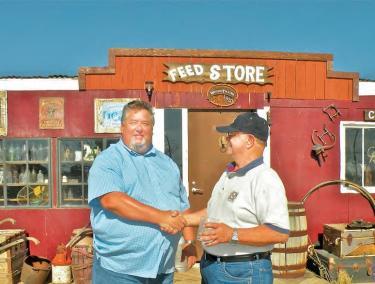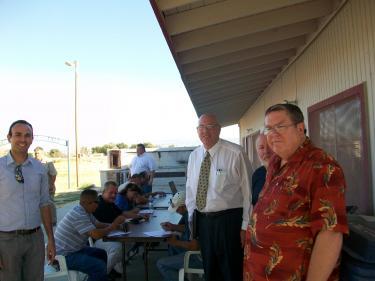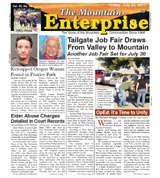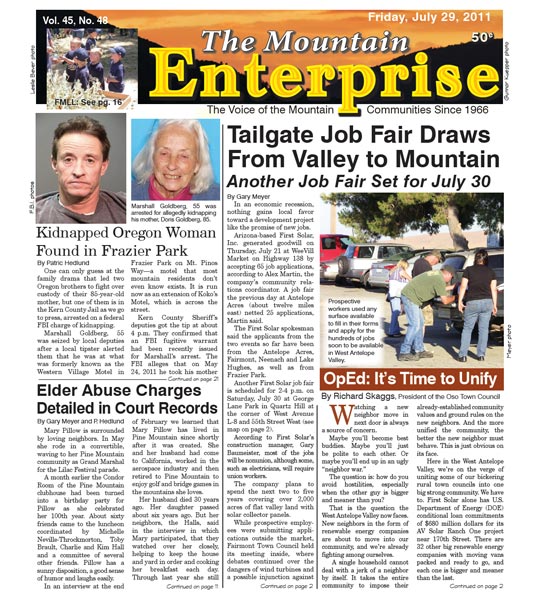
Image 1 of 2
First Solar, Inc. Construction Manager Gary Baumeister shakes hands with Richard Skaggs on July 10 at a barbecue and informal job fair for the neighborhood. They are standing in front of the whimsical Hiker Town Pacific Coast Trail hostel for hikers, maintained by Mr. and Mrs. Skaggs. Skaggs is president of the Oso Town Council which is seeking to move toward more unity between Western Antelope Valley rural town councils.
Image 2 of 2
In the background, residents of the Antelope Acres area filled out applications for construction-related jobs for the First Solar AV Solar Ranch One on July 20. It will be a 2,093-acre solar utility. First Solar will also build the NRG solar project. Standing in the foreground (l-r) are Alex Martin (with the community relations team for First Solar), Norm Hickling (5th District Field Deputy for L.A. County Supervisor Michael Antonovich) and Karl Humphreys, who has argued strenuously for concessions from the company to benefit the surrounding communities. He and others in the rural town councils argue that they will be forced to watch the rural landscapes around them be transformed by highly-subsidized green energy developers. They say if they cannot stop these changes, communities deserve to benefit and mitigations need to be in place.
Update -Frazier Park, Neenach,Fairmont (Friday, July 22, 2011 at 4 a.m.)—The First SolarJob Fair will be from 2-4 p.m. on Saturday, July 30 at George Lane Park in Quartz Hill at the corner of West Avenue L8 and 55th Street West. That is the date, place and time confirmed by Alex Martin of First Solar, Inc. We asked twice to confirm the time.
"The place is booked until noon and we need about an hour to set up," Martin said, confirming the application process will begin at 2 p.m. See next week’s issue of The Mountain Enterprise for a map and complete directions [on newsstands Thursday, July 28].
Drive time to the worksite from Gorman would be about 18 minutes. The job fair site on July 30 is about 12 miles to the southeast of the construction site.
These are primarily construction jobs that may last as long as two years. First Solar Construction Manager Gary Baumeister said that he is looking for people who have "a good work ethic," who can pass the drug test, "and who want to work." He said that prior experience with constructing solar arrays is not necessary: "We will train people." Baumeister said he expects to hire 200-300 people, and that "peak work force" will rise to about 350.
On June 30 it was announced that Next Solar, Inc. is in line to receive $4.5 billion in federal, Department of Energy (DOE) loan guarantees, as an incentive to accelerate the building of "clean energy" infrastructure in the United States. They plan to build two utility-scale sites in California (in the historic Fairmont area of the Western Antelope Valley and in Riverside County, the largest ever constructed in North America) and one in Arizona. They will also receive property tax concessions from the state of California. Because public money is involved, there is a requirement that these construction jobs be paid at "prevailing wage," which is expected to be between $25-$40 per hour, depending upon the task required.
First Solar has also contracted to build a facility for another company, NRG Solar, also in the Western Antelope Valley, according to Oso Town Council sources. NRG Solar also won an early Conditional Use Permit at the end of 2010 from L.A. County and has made agreements with the Fairmont Town Council regarding concerns for aesthetics, height of fences, wildlife passage, hiking and equestrian trails and other concerns.
First Solar has a "pre-sale" contract with Southern California Edison for the expected 230 megawatts of electricity to be generated by its Antelope Valley First Solar Ranch One (AVSR One) facility. That is anticipated to be enough to power about 50,000 homes.
Update -Frazier Park and Neenach,Fairmont, Antelope Acres (Thursday, July 21, 2011 at 4 p.m.)—Richard Skaggs of the Oso Town Council writes: We have a location for the First Solar Lancaster Job Fair – it’s George Lane Park in Quartz Hill at the corner of W. Ave. L8 and 55th St. W on July 30th.
We don’t have a time yet, but Alex Martin of First Solar will provide that as soon as it is final. In the past, the time mentioned was 10 a.m. to noon and from 1 to 5 p.m. We wil post the confirmed information as soon as it is availalble.
Part Two of From Fire to ‘Hire’
By Patric Hedlund
The walls of WeeVill Market held loud and bitter meetings between members of multiple rural town councils and executives of First Solar, Inc. in June. WeeVill squats in a dusty parking lot on a long, straight stretch of Highway 138 (between the Grapevine and State Route 14). This section of the desert road is known by Western Antelope Valley residents as ‘Blood Alley’ for the nasty accidents that occur there.
At the meetings in June, residents said they felt they had been steamrollered by deals made between the company, Los Angeles County politicians and regional planning bureaucrats.
They said a Conditional Use Permit for First Solar was engineered before November 2010 without consultation with the people who, within two years, will be living right next door to the biggest photovoltaic solar farm in North America. They said the company needed to come speak with them in detail before beginning comstruction, as planned, on July 5. Development Director Jack Pigott did not make that a priority.
Then a small gift of fate was granted to the Town Councils. A 74-acre fire on First Solar property broke out on July 2. Neighbors grabbed tractors and created firebreaks to contain it before it could spread. It took the fire department about 40 minutes to respond, residents report. First Solar had just learned one of the lessons of the region that neighbors had been trying to tell them about. Things changed. On July 7 a meeting was held at Lancaster’s Hampton Inn which began with more loud complaints, but ended with an invitation to a barbecue in Neenach which Construction Manager Gary Baumeister accepted. On July 10 a friendly barbecue was hosted by Oso Town Council members at whimsical ‘Hiker Town’ on a small ranch along the Pacific Crest Trail. At that meeting Baumeister accepted job applications from about 35 residents of the region.
Jobs became the olive branch that First Solar saw as possibly averting legal action by the councils. If the company’s rush to start building was slowed, huge federal loan guarantee incentives might be lost.
The jobs offered are primarily construction jobs. "You don’t need specialized skills, just a good work ethic," said Construction Manager Gary Baumeister, "we’ll provide training."
In what some participants called a ‘historic meeting’ July 14, executives of First Solar, Inc. met at Fire Station 129 in Palmdale with members of the Oso and Fairmont Rural Town Councils for an unprecedented summit meeting to work out their differences. L.A. County Supervisor Michael Antonovich’s Field Deputy Norm Hickling moderated.
First Solar’s attorney came in from San Francisco to sit on one side of the table with Vice President of State and Local Government Affairs Jim Woodruff, Construction Manager Gary Baumeister, Project Manager Tony Perrino and Permits Specialist Roy Skinner. On the other side of the table were Oso Town Council members Gerard Conroy, Richard Skaggs and Robert Plumlee, along with Fairmont Town Council members Barbara Rogers and David Jefferies. Antelope Valley tree farmer Pat Chiodo sat at the table with the Fairmont council members. Norm Hickling kept the meeting moving forward. Community members and two journalists were also present. Oso Town Council said they wished to have transparent proceedings.
A businesslike tone characterized most of the dialogue, which covered a list of concerns raised by the residents of the Western Antelope Valley with an impressive spirit of agreement and accommodation. Residents have been told L.A. County may grant permits to a staggering 33 utility-scale solar and wind-farms in their area which has had, until recently, wide open landscapes and unobstructed skies.
The cumulative impacts threaten to completely transform the valley. Residents fear, with reason, that the installations will chop their surroundings into an industrial grid crosshatched by 8 foot penitentiary-style chain-link and barbed wire fencing. They are concerned about obstruction of wildlife movement and aesthetic concerns for their children. They are concerned about trails and jobs.
They are also concerned about infrastructure maintenance and the planned deeding of the 480 acre Fairmont Buttes environmental mitigation land over to an entity that plans to pass the deed to the Santa Monica Conservancy.
“They don’t live here, we do,” thundered Chiodo. Jefferies told of a rave concert that was underway in the Buttes recently until neighbors took action. Residents also objected to a chain-link fence they said was going in around the Buttes. Council members said there is local conservancy expertise with a good track record that is qualified to manage the mitigation land. Some challenged the competence of the Santa Monica Conservancy for preserving their Western Antelope Valley landmarks and said the transfer of the deed to the Buttes out of local hands is legally flawed.
Town council speakers emphasized that the precedents set by First Solar’s AVRanch One will determine the standards that will be demanded from the projects that follow them. This is the first project to begin building, and it is possibly the largest.
250-350 Jobs Developing
The first priority is securing a competitive opportunity for residents of the region to apply for construction jobs. Some fear the company would prefer to bring in jobbers who have their own personnel. In public meetings, in press releases and in filings for federal subsidies, Solar One executives have said they anticipate that between 250 to 350 people may be employed to build out the 2,000 acre, 230 megawatt (MW) solar power generating facility.
“I”m building a parking lot for 400 cars,” Baumeister said.
Prevailing Wage
Because First Solar, Inc. is rushing into construction to obtain federal and state incentives— which may include up to $4.5 billion in federal loan guarantees (for three projects, including this one in Antelope Valley)—they are required to pay “prevailing wage,” which executives have said may range between $25 to $40 per hour, depending upon the type of work required.
Now Western Antelope Valley Town Councils are coming together to hold quick job fairs.
The next is scheduled for Saturday, July 30 at 2 p.m. on Saturday, July 30 at George Lane Park in Quartz Hill at the corner of West Avenue L8 and 55th Street West.
A map of the location will be in next week’s issue of The Mountain Enterprise, which will be on newsstands on Thursday, July 28.
Earlier in this series:
2011-06-24 Fairmont Town Council’s Solar Merry-Go-Round Ride
2011-06-24 Update: Fairmont Town Council Asks for Emergency Planning Meeting on First Solar Intentions
2011-05-06 Where the Trees Grow Sideways and the Sun Burns Bright
2011-04-29 ‘Where the Trees Grow Sideways and the Sun Burns Bright’
2011-04-08 150 Hear about NextEra Wind Farm at The Lakes Town Council
2011-04-01 Fairmont Council Votes To Settle with NRG Solar
2011-03-25 Fairmont Town Council Makes Progress on NRG Appeal
l2011-03-11 Oso Town Council Is Revived as Wind and Solar Farms Arrive
2011-02-11 Neenach-Fairmont Area Meet Energy Developers–Part Three
2011-02-04 Neenach-Fairmont Meet With Energy Developers-Part Two
2011-01-28 Neenach-Fairmont Meet With Energy Developers
2011-01-21 Energy Groups Rushing into Neenach Area
2011-01-14 Breaking News: Solar Companies Seek Thursday Meeting in Neenach
2011-01-07 Neenach Area Files Two Appeals to L.A. County Solar Farm Permit :
2010-12-31 Breaking News: Neenach Area Residents Appeal Permit for 800-Acre Solar Farm
By Patric Hedlund
It’s hard to say what a bad week might feel like for an $11 billion corporation named by Forbes Magazine as the fastest growing technology company in America two years in a row, but First Solar Inc.’s unpleasant encounter with the Fairmont Town Council in Western Antelope Valley this week caught the eye of some Wall Street investors. The company, known as FSLR on the NASDAQ, is seeking to place a 2,100 acre, 230 megawatt system, the largest in California, in the Fairmont area.
With loan guarantees and grants, there is about $215 million in federal incentive benefit to FSLR if it can commence construction before September 30, one Wall Street analyst who contacted The Mountain Enterprise estimates. FSLR received a certification of its Environmental Impact Report (EIR) for the Antelope Valley Ranch One project in November 2010, shortly after the Fairmont Town Council was formed.
FSLR hopes to break ground by July 5, development manager Jack Pigott told about 45 Fairmont residents June 27. The group gathered at the WeeVill Market, one of the few public structures along a flat stretch of Highway 138, about 15 miles west of Lancaster.
After hearing a presentation by Pigott and Roy Skinner, First Solar permits specialist, Fairmont Town Council members and residents asked pointed questions about the transformations that will take place in their valley from the cumulative impact of 33 utility-scale renewable energy installations slated to be built in their area.
Their primary grievance, according to council president David Kerr, is the lack of consultation with the neighbors who will be most immediately affected by the facility.
Council President David Kerr said that First Solar had not notified its immediate neighbors to give them an opportunity to be part of the EIR hearing process. First Solar representatives said that L.A. County had notified neighbors in mailings. Residents ridiculed the reply, saying that rural mail addressed to street boxes is often not delivered nor received, and that none of them had received notification. Only one resident, Pat Chiodo, said he had been to an EIR hearing at Antelope Acres Town Council, about 15 miles from the Fairmont area.
Residents said it appears that L.A. County employees in Supervisor Antonovich’s office or in downtown L.A. had misinformed the solar company regarding who represents the 2,000 residents who live where the company hopes to build AV Solar Ranch One.
“We are the ones who will be paying for this project and the other ones that want to build here, with the change to our way of life,” Kerr said.
The council voted to send a letter seeking an urgent emergency meeting with the Los Angeles County Department of Regional Planning.
The letter, signed by residents as well as the council, speaks of "glaring insufficiencies" in the design and construction plans for AV Solar Ranch One.
Specific complaint was made about what was characterized as the failure of the company to make "meaningful" contact with residents. It also said the proposed project is inconsistent with the "principles and values stated in the [L.A. County] Antelope Valley Area Plan."
In strong words, the letter said that architects of the project are obliged to make a "collaborative effort" with community members, but that they had not. The council’s letter calls AV Solar Ranch One "a bullying, unwanted neighbor whose pursuit of profits apparently has blinded it to any concepts of area cooperation," then asks for an immediate review of the project "prior to commencement of construction."
Pigott said many of the concerns mentioned by residents had already been addressed in the EIR, and reminded the group that the project had already been approved by downtown L.A. He said that the Fairmont Town Council should become familiar with the EIR mitigation components before submitting the letter.
Cumulative impact issues were raised throughout the meeting. Many spoke of the 7-foot chain link fences topped with barbed wire throughout the valley around 33 projects that will turn the valley’s open landscape into a penitentiary environment.
One father said “I want to see a landscape plan to hide that fence all around the whole project. It is like living next to a correctional institution. I am for solar, but you need to come in and handle the concerns of the community. We’re no different from Napa, Sonoma and communities up north, [that have] nice pine trees [to screen solar farms]. The idea of using Joshua trees won’t work. We don’t want to look at that—and most of them die. My kids will get stuck looking at a chainlink fence desert.”
Pigott dismissed their anxiety, saying the setbacks and landscaping along paved roads for his project would be adequate. He repeated that the company adhered to the requests of L.A. County Planning Department personnel. Rural residents scoffed at the "ignorance" of urban planners regarding the needs of the rural community.
The town council voted to table “for the moment” a motion to file a restraining order that could delay the beginning of AV Solar Ranch One construction.
The next day, on Tuesday, June 28, Riverside County Supervisor John Benoit introduced a motion regarding a two percent franchise fee on another large First Solar installation planned to be built in Riverside County. According to Benoit’s press coordinator, the motion has been sent for further study by county staff. The two percent fee could total $3.5 million a year in revenues to the county, it was estimated it could mean nearly $100 million over the life of the project.
When Benoit’s proposal was mentioned at the Fairmont meeting, Pigott laughed. "We will never pay that," he said.
First Solar’s stock closed on Wednesday, June 29 at $129.42. Recent news of popular desire in Germany to close down its nuclear power plants due to safety concerns make First Solar’s thin film photovoltaic offerings hotter than ever. The company already has large solar energy installations in Germany. The day after Fairmont Town Council submitteed its letter, FSLR stock rose $4.81 per share.
This is part of the July 29, 2011 online edition of The Mountain Enterprise.
Have an opinion on this matter? We'd like to hear from you.


